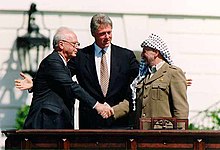This is an old revision of this page, as edited by 211.28.220.48 (talk) at 14:36, 16 May 2005 (→First term as prime minister). The present address (URL) is a permanent link to this revision, which may differ significantly from the current revision.
Revision as of 14:36, 16 May 2005 by 211.28.220.48 (talk) (→First term as prime minister)(diff) ← Previous revision | Latest revision (diff) | Newer revision → (diff)
Yitzhak Rabin (Hebrew יִצְחָק רַבִּין) (March 1, 1922 – November 4, 1995) was an Israeli politician and military general. He was the fifth Prime Minister of Israel from 1974 until 1977 and again from 1992 until his assassination in 1995 by Yigal Amir. He was the first Israeli-born Prime Minister of Israel, the only Prime Minister to be assassinated and the second to die in office. Levi Eshkol was the first Prime Minister to die in office.
Youth and Palmach
Rabin was born in Jerusalem in what was then the British Mandate of Palestine. He grew up in Tel Aviv, where his family moved when he was one year old, and in 1940 he graduated with distinction from the Kadoori Agricultural High School. His matriculation was his last formal education, with the exception of some military strategy courses which he later took in the United Kingdom. He aspired to become an irrigation engineer.
In 1941, during his practical training at Kibbutz Ramat Yochanan, Rabin joined the Palmach section of the Haganah, and rose to the position of Chief Operations Officer in October 1947.
IDF Service
During the Israeli War of Independence, he directed the defence of Jerusalem and fought the Egyptian army in the Negev. In 1962 he rose to the position of Chief of Staff in the Israel Defense Forces (IDF).
Under his command, the IDF achieved an overwhelming victory over Egypt, Syria and Jordan in the Six Day War. After the Old City of Jerusalem was captured by the IDF, Rabin was among the first to visit the old city, and then delivered a famous speech on the top of Mount Scopus at the Hebrew University.
Ambassador and Minister of Labor
Following his retirement from the IDF, he became a diplomat, serving as ambassador to the United States beginning in 1968. In 1973, he was elected to the Knesset as a member of the Labor Party, and was appointed Minister of Labor.
First term as prime minister
On June 2 1974, he was elected Party leader and succeeded Golda Meir as Prime Minister of Israel.

This term in office was most famous for Operation Entebbe, in which, on his orders, the IDF rescued passengers of a plane hijacked by Palestinian terrorists. Rabin resigned from office after two crises hit him: the arrival of four F-15 jets on Sabbath led to the breaking up of his coalition; and the exposure of a US Dollar bank account held by his wife Leah Rabin, an act forbidden at that time by Israeli currency regulators. Rabin took responsibility on his wife's account and resigned from office.
Opposition member and minister of defence
Following his resignation, Likud's Menachem Begin was elected in 1977. Rabin was later hailed by many commentators for his resignation, who said that this was a sign of integrity and responsibility.
During the late 1980's Rabin was a Minister of Defence in several unity governments and enacted harsh measures to break the first Intifada. He was quoted as saying 'We should break their hands and legs' (referring to Palestinian rioters).
Second term as prime minister
In 1992 he was once again successfully elected Prime Minister. He played a leading role in the signing of the Oslo peace accords, which created the Palestinian Authority and granted it partial control over parts of the Gaza Strip and West Bank. During this term of office, Rabin also oversaw the signing of a peace accord with Jordan.
For his role in the creation of the Oslo Accords, Rabin was awarded the 1994 Nobel Peace Prize, along with Yasser Arafat and Shimon Peres. The Accords greatly polarized his image in Israeli society, some seeing him as a hero for advancing the cause of peace and some seeing him as a traitor for giving away land they saw as rightfully belonging to Israel. Also, Rabin's government was kept in office with the (somewhat concealed) assistance of Arab-Israeli parties in the Knesset.
Assassination and Memory
On November 4, 1995, Rabin was shot by the extreme right-wing activist Yigal Amir, after attending a peace rally in Tel Aviv's Kings of Israel Square (which is now the Yitzhak Rabin Square). Fatally wounded, he died on the operating table at the nearby Ichilov Hospital in Tel Aviv.
Questions were raised due to alleged serious inconsistencies in the evidence, because some medical and witness testimonies suggest that Amir shot blanks, and that the real bullets were fired at a later time. Main article: Yitzhak Rabin assassination conspiracy theories.
A national memorial day for Rabin is set on the murder date, and the square in which he was murdered was named after him, as well as many streets and public foundations.
Further reading
- Karpin, Michael and Friedman, Ina, "Murder in the Name of God - The Plot to Kill Yitzhak Rabin", ISBN 0805057498.
- Chamish, Barry "Who Murdered Yitzhak Rabin"
Related articles
External links
| Preceded in first term by: Golda Meir |
Prime Ministers of Israel | Succeeded in first term by: Menachem Begin |
| Preceded in second term by: Yitzhak Shamir |
Succeeded in second term by: Shimon Peres |